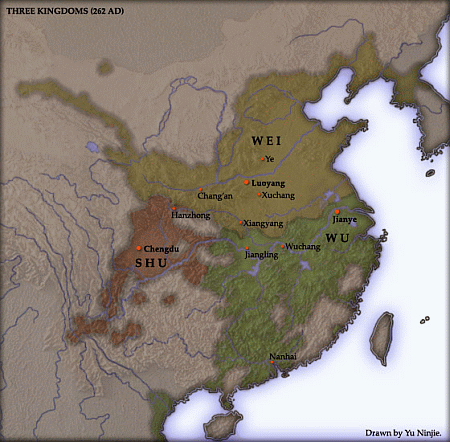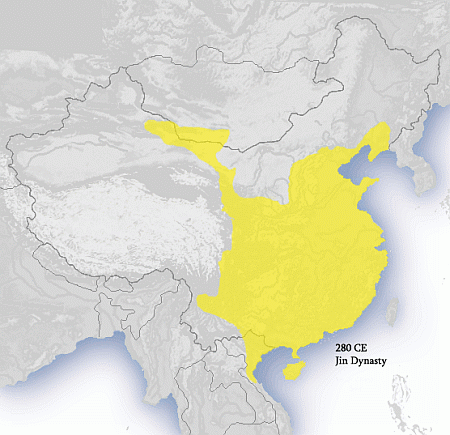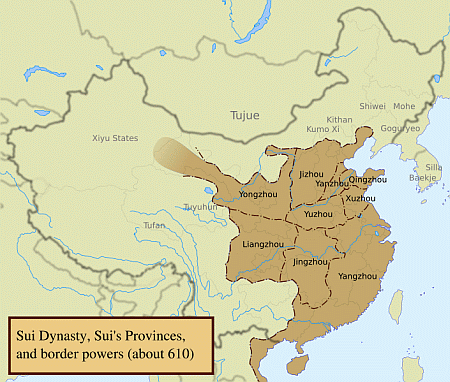|
|
| Chinese
History |
Imperial
China - Post Han
|
|
Post Han
An 'Idiot's Guide' to one of the most
complicated period's of Chinese History...
Three Kingdoms 220–280
Wei, Shu & Wu
Jin Dynasty 265–420
Western Jin
Eastern Jin
16 Kingdoms 304–439
Southern & Northern Dynasties 420–589
Sui Dynasty 581–618
(They re-unified China)
Note:
I have grouped this 300 year period together in order
to aid comprehension, and also give insight into the
years of instability that lay between the Han Empire,
and the Sui Empire
Demise of the Han Empire
During this period China descended into various warring
factions and Kingdoms or States = Warlords (Again),
so in order to try and present this in a less confusing
way, I have combined several traditional stages of Empire
into one section ...
... Then driven a Steam-roller through it all repeatedly,
or until it makes simple sense!
What is beyond doubt is that throughout this chaos the
dominant people were of Han Chinese descent. We will
begin from the last section, with the disintegration
of the Han Empire, and this next 400 years see various
Warlords controlling regions of China.
China is not again reunited as one Country until the
short-lived, but strategically important Sui Empire
Three Kingdoms 220–280
Wei, Shu & Wu

Map courtesy of Yu Ninjie
Reference: Wikipedia http://en.wikipedia.org/wiki/Three_Kingdoms
The Three Kingdoms period actually begins in 184 AD
with The Yellow Turban Uprising. [This is considered
to be a part of The Six Dynasty's period by academics
- but you probably don't want to know about that, as
things are confusing enough?]
So: The Han Empire gradually loose
all but ceremonial status, and are eventually usurped
The earlier, "unofficial" part of this period,
from 190 to 220, was marked by infighting between warlords
in various parts of China. The middle part of the period,
from 220 and 263, was marked by a more militarily stable
arrangement between main three rival states, Cao Wei,
Shu Han, and Eastern Wu. The latter part of this period
was marked by the collapse of the tripartite situation:
first the destruction of Shu by Wei (263), then the
overthrow of Wei by the Jin Dynasty (265), and the destruction
of Wu by Jin (280).
This was the bloodiest period of Chinese history,
and population dropped from 50 million at the end
of the Han Empire, to a mere 16 million by the Early
Jin period (Although the census figures may be incomplete
and therefore misleading). What is not beyond question
is that during this period millions of Chinese people
died.
Perversely, this era has been highly romanticised
in the cultures of China, Japan, Korea, and Vietnam.
Operas, folk stories, novels, films, television serials,
and even in video games. The best known of these is
undoubtedly the Romance of the Three Kingdoms
This is all relatively Han Chinese history, but what
of other regions of modern China during this period?
This will follow at a later date, but you can find
out where the Shu Kingdom originated here
Meanwhile, The Jin became a virtually autonomous and
warring Kingdom that was sort-off part of the Wu Kingdom.
The politically sensitive areas were around modern Hangzhou
in the Yangtze Basin, but you should consider that in
terms of real power: The Wu reigned in the East and
South, whilst the Jin controlled the West and Centre.
Synopsis:
... Let's make a list:
1. The Han are eventually overthrown: as an almost inevitable
ricochet of The Yellow Turban Uprising
2. A faction led by Warlord Cao Cao seize Northern power
by harbouring the exiled Emperor and using his official
mandate by proxy, to control other vassal Warlords
3. In the first month of 220, Cao Cao dies, and his
son Cao Pi forces Emperor Xian to abdicate, thus ending
the Han Dynasty. He named his new state Wei and made
himself emperor at Luoyang
4. The fate of Shu in the 'South' (This actually means
Sichuan Province - I do wish Chinese would use geographical
and not conceptual maps!) is that of their young General
Sun Ce. After many victories for his Shu Lord, Sun Ce
is offered control of the Shu Kingdom by the Wei
5. The Wu continued doing their own thing in the East
and 'real' South; hence:
6. Dominion of the north completely belonged to Wei,
whilst Shu occupied the southwest, and Wu the south
and east. The external borders of the states were generally
limited to the extent of Chinese civilization. For example,
the political control of Shu on its southern frontier
was limited by the Tai tribes of modern Yunnan and Burma,
known collectively as the Southern Barbarians, and you
can consider the Pearl River to be the border during
this period
So that's all sorted then?
Fall of Shu
Conquest of Shu by Wei
As the Cao clan declined in influence, so did the Shu.
This vacuum was filled by the eunuch faction and corruption
rose. In 263, Wei launched a three-pronged attack and
the Shu army was forced into general retreat. By the
winter of the year, the capital Chengdu fell due to
the strategic invasion of Wei by Deng Ai - who invaded
Chengdu personally. The emperor Liu Shan thus surrendered.
The state of Shu had come to an end after forty-three
years.
Fall of Wei
Cao Huan succeeded to the throne in 260 after Cao Mao
was killed by Sima Zhao. Soon after, Sima Zhao died
and his title as Lord of Jin was inherited by his son
Sima Yan. Sima Yan immediately began plotting to become
Emperor but faced stiff opposition. However, due to
advice from his advisors, Cao Huan decided the best
course of action would be to abdicate, unlike his predecessor
Cao Mao. Sima Yan seized the throne in 264 after forcing
Cao Huan's abdication, effectively overthrowing the
Wei Dynasty and establishing the successor Jin Dynasty.
This situation was similar to the deposal of Emperor
Xian of the Han Dynasty by Cao Pi, the founder of the
Wei Dynasty.
Fall of Wu
Conquest of Wu by Jin
During 252, the kingdom of Wu went into a period of
steady decline. Successful Wei suppression of rebellions
reduced any opportunity of Wu influence. The fall of
Shu signaled a change in Wei politics. After Jin's rise,
Emperor Sun Xiu of Wu died, leaving the throne to Sun
Hao - became a tyrant, killing or exiling all who dared
oppose him in the court.
In 269 Yang Hu, Jin commander in the south, started
preparing for the invasion of Wu by ordering the construction
of a fleet and training of marines in Sichuan under
Wang Jun. Four years later, Lu Kang, the last great
general of Wu, died, leaving no competent successor.
The planned Jin offensive finally came in the winter
of 279. Under the strain of such an enormous attack,
the Wu forces collapsed and Jianye fell in the third
month of 280. Emperor Sun Hao surrendered and was given
a fiefdom to live out his days on. This marked the end
of the Three Kingdoms era and heralded a slightly more
stable era
Jin Dynasty 265–420
In many ways the Jin Empire is an enigma - they fought
for many years and defeated powerful foes. Then almost
as soon as they build their version of The Han Empire
- it all starts to fall apart again!
Western Jin (265 - 319)
Continuing from above, The Jin Empire swept to power
and established it's Capital at Luoyang in Henan Province.
With strong leadership from Emperor Wu (Sima Yan), they
brought a brief period of respite and unity to China.
However, they were greatly weakened by the later War
of the Eight Princes, and by 311 were driven out by
'Han Zhao' forces (See 16 Kingdoms below). Their next
Capital of Chang'an (Another name for Xi'an) lasted
a mere 4 years, and again the Han Zhao defeated them.
This time they fled to Jiankang (near modern day Nanjing)
Eastern Jin (319 - 420)
In 317 what was left of the Jin Empire re-established
itself, and this period is known as the Eastern Jin.
Basically they lost control of the Northern part of
the realm. Nanjing remained the Capital for over 100
years. However, this period was also marked by political
intrigue, wars and uprisings - so much the same as before
really, except they didn't loose any important battles
16 Kingdoms 304–439
The Sixteen Kingdoms (there are actually more of them,
and this excludes the Wei Kingdom), were a collection
of numerous sovereign states in China proper and its
neighbouring areas. They existed at the times of the
Jin and other Kingdoms, but were independent. From 304
initially, and after the retreat of the Jin Dynasty
to 'South China', and before the establishment of the
Northern Dynasties. They included Kingdoms in Northern
Korea and China. Please see Wikipedia if you want the
unexpurgated version:
http://en.wikipedia.org/wiki/Sixteen_Kingdoms
Meanwhile:
Remnants of the Han and Zhou (Alt. Zhao) Empires were
active in the North, and represent the Xiongnu tribes
of Shanxi, Shaanxi, and part of Inner Mongolia. However,
these are not herdsmen or nomads, these are highly educated
aristocrats, who always held the title Emperor or Wang
These two Kingdoms formed a stout alliance, and are
known as the Han Zhou or Han Zhao (Means the same).
They form two of the disparate 16 Kingdoms, and are
responsible for driving back the Jin Empire
In Summary
This period of general unrest maps geographically, either:
1. Continuation of Chinese Empire under the Jin
2. Fights for independence by Kingdoms and people who
never considered themselves to be Han Chinese
3. Royal Houses seeking to recreate Han and former Empires
= before the Jin

Map courtesy of Wikipedia:
http://en.wikipedia.org/wiki/Jin_Dynasty_(265–420)
Wu Hu
Wu Hu is a collective name for Northern nomadic tribesmen.
One of the premier is called the Xiongnu, and they are
regarded as the origins of the Huns. However, there
were many of them, all pushing Southwards from the steppes
of Mongolia and Russia
Regarding Chinese history, our interest lies in that
their aim was to establish a good life for their tribe
on the lush central plains of China. Throughout the
millennia of Chinese history, they have always feared
invasion from the North - hence The Great Wall!
During this period of history, the Xiongnu were well
settled in Shanxi, Shaanxi, and part of Inner Mongolia
Provinces. Other Wu Hu tribes were pressing them from
the North, or active along other Northern frontiers
of China, and this means wars, many of them!
The Wu Hu were academically and tactically brilliant
enough to reunify China. However, having won the battles,
they stopped just short of complete control - but this
would change...
Southern & Northern Dynasties 420–589
Abdication of Jin Emperor Gong in 420 in favour of Liu
Yu, then Emperor Wu, ushered in the Liu Song Dynasty
and the Southern Dynasties.
Meanwhile North China
was ruled by the Sixteen Kingdoms, many of which were
founded by the Wu Hu, the non-Han Chinese ethnicities.
The conquest of the Northern Liang by the Northern
Wei Dynasty in 439 ushered in the Northern Dynasties.
The Southern and Northern Dynasties was an age of
civil war and political disunity. However it was also
a time of flourishing in the arts and culture, advancement
in technology, and the spread of foreign Mahayana
Buddhism. It was also a time of migration, and many
people moved from North China to the South (South
of the Yangtze River that is). In the real South,
'Barbarians' were also assimilated into everyday Chinese
culture
Summary
This is basically as before, except the names have
been changed by historians. There is also a tendency
for weaker Kingdoms in the North to be assimilated
into larger ones. In particular, the Wei Kingdom becomes
very powerful. Now if only somebody could bring it
all together?
Sui Dynasty 581–618
Basically a period of two Monarchs: Emperor Wen and
his cohort and successor, Emperor Yang.
A short-lived and overly maligned Dynasty, mainly
because of their overzealous use of force. However,
they achieved one great thing, and that was to reunite
China. Without them it is likely that China would
nowadays be many separate Countries!
Not only did they Sui re-unify China, but they also
made many reforms and developments. Here's a list:
1. Created The Grand Canal
2. Extended The Great Wall
3. Instigated a fair system of land use called The
Equal-field System - which substantially reduced the
rich/poor divide
4. As a result, agricultural productivity increased
5. Centralised Government power (3 Departments and
6 Ministries)
6. Re-unified and standardised coinage
So how did this great Empire suddenly disappear?
The Sui Rulers were driven to complete The Grand Canal.
This required heavy taxes and great manpower, however...
... after re-unifying most of China, Emperor Yang
also determined to bring the Korean Kingdom of Goguryeo
under direct control. This proved to be a mammoth
undertaking, and far too heavy a burden for the fledgling
Empire to withstand. Higher taxes and widespread conscription
caused much animosity
Soon the Empire ended with defeat of Yang, and the
dynasty disintegrated through a combination of popular
revolts, disloyalty, and assassination.

Now I never claim to be a historian, nor politician
- but what I do find very interesting is the fact
that if I take the names and dates out of the above
- you would think it is all the same thing, over,
and over again.
|
|
This
information is as supplied by Wikipedia, as dated March
2009 or later, and/or other reliable sources.
Maps (Unless stated otherwise)
are provided in association with Thomas Lessman
Web: www.worldhistorymaps.info
Disclaimer:
Please check this information yourself as it may alter
without notice, and whilst we try our best to ensure
it is correct, please do not hold us responsible for
any errors - this is intended as a simple guide only |
|
| Search
this Website |
|
|
| Our
Friends |
Excellent
& Free Online Chinese Language Portal

Thousands of free print-friendly Chinese reference sheets,
tests and revision aids.
Easy Learning format &
Listen to Spoken Words |

Professional
Visa Services
Company
Formation Packages
.
|

British Foreign Office
Resource and Advice for Travellers Worldwide |

Chinese Embassy in UK
Information About China
International Relations
Visa & Consular |

UK Embassy in China
Information About UK
International Relations
Visa & Consular |

|
Excel
Education |
Languages Courses
Study Abroad
Employability
Summer Camps
Information for Teachers |
|

Excellent and relaxing base to
explore this most beautiful of regions in all China! |
Down The Road.org
How We Traded Our Ordinary Lives For a Global Bicycle Touring Adventure

See
Us in China |

Empowering Underprivileged Children
& Their Communities = Worldwide |
 |

Based in Shangri-la,
Yunnan
Province
Dedicated to Exploring Remote Areas of China
Committed to Nature Conservation and Preserving Ethnic
Cultures & Traditions
|

Based in Xi'an,
China's Premiere Travel Agency and International Travel
Community -
Committed to providing:
Best travel deals & current information for all
International Travellers |

Pearl Dragon
Vast
Online Trading and Information Resource
Link goes to Chinese Tourism and Galleries Section |
|